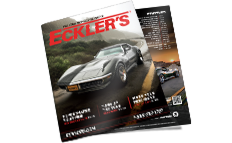Sales Techs Available: 1-877-305-8966
FIRST CORVETTE PEDAL CAR
The 1953 Corvette Pedal Car
Overview
This is the only known Corvette Pedal Car built by Harley Earl outside of GM. Were others built inside GM? Nobody knows the answer. The pedal car was constructed by industrial designer Clair Samhammer at Harley Earl Incorporated in Warren, Michigan, between 1953 and 1954. Samhammer supervised and worked hands-on with a four-person team.
The project, which was not a full-time effort, took approximately three months to complete. The estimated cost to build the pedal car was $15,200—equivalent to $106,000 today. For comparison, a real production 1953 Corvette cost only $3,734.55.
Why Was the Pedal Car Built?
The pedal car was reportedly created to boost Corvette sales, which were slow at the time. The plan was to sell the pedal cars to dealerships as promotional items or as an incentive for purchasing Corvettes. While it’s possible this project was the catalyst for GM's later pedal car program, no records exist to confirm this. Other reasons for building the car remain speculative.
The car, designed to carry a child driver and passenger, featured side-by-side pedals for both occupants. Only one car was known to have been built.
Specifications
Dimensions
- Length: 64.5 inches (168 cm)
- Width: 29 inches (75 cm)
- Height (to door top): 13.5 inches (35 cm)
- Height (to steering wheel): 21 inches (55 cm)
- Axle-to-Axle Distance: 38 inches (99 cm)
Build Details
- Scale: 1:3
- Body: Hand-laid fiberglass
- Original Colors: Polo White exterior and dash; red underside
- Weight:
- Original: 150 lbs
- Restored: 100 lbs (reason for weight reduction unknown)
Components
- Trim:
- Scaled from original GM-supplied body loftings
- Likely machined at the Stiller Brothers shop in Royal Oak, Michigan
- Hubcaps possibly made by Lyon Incorporated
- All components (trim, nuts, bolts, screws, washers) made of brass to avoid issues with dissimilar metals
- Emblems:
- Original emblems made using the SEE-DEEP process
- Restored emblems laser-engraved on acrylic and painted
- Headlights: Non-functional but designed to appear operational
- Tires: Goodyear Diamond Tread 10x2.75 pneumatic tires with painted whitewalls
Unique Features and Anomalies
The pedal car includes features and trim details inspired by EX-122, the Corvette concept car, rather than production models. These anomalies include:
- License Bezel: 14 screws instead of the 8 found on production models
- Headlight Rings: Two screws per ring, compared to one on full-size models
- Hubcaps: Vertical spinners, seen only on early 1953 models and EX-122
- Fender Scoops: Present on EX-122 but absent on production models
- Chevrolet Branding:
- Hubcaps include the Chevrolet shield and bowtie
- No Chevrolet side script, unlike production models
Historical Context
The car was owned by George A. Lyon I and later by George A. Lyon II in Birmingham, Michigan. Photographs of the finished car feature Craig and Gary Hughes, sons of Harley Earl Incorporated designer Bob Hughes.
The car was rediscovered in Michigan in 2002, reportedly in an old carriage house. It was sold at the Saline Swap Meet in Ann Arbor on April 28, 2002, and resold on eBay on May 5, 2002.
Restoration
The car underwent 500 hours of restoration, beginning May 15, 2002, and completed May 12, 2003. The chassis was recreated using photographs of the original.
Notable Appearances
- Eyes on Design: 2003, Warren, Michigan
- Corvettes at Carlisle: 2003, Carlisle, PA
- National Corvette Museum: August 28, 2003
- Concours d’Elegance at Cranbrook: July 25, 2004
- GM Heritage Center: July 26, 2004
Urban Legends and Myths
- This car is not related to the Eska pedal cars of 1956–1957.
- It was never known as a "Kiddie Corvette."
- The Austin J40 Pedal Car was not used as a reference.
- There is no connection to the Shah of Iran.
Unsolved Mysteries
Several questions remain unanswered:
- Where was the car located between Birmingham (1957) and Ann Arbor (2002)?
- Why does the license bezel have 14 screws when no full-size bezel with this configuration exists?
- How was the project funded, and how did it come into the Lyon family's possession?
- What happened to the original molds, chassis, wheels, hubcaps, and steering wheel?
- Where is the carriage house where the car was found?
- Why did the completed car feature a "LYON" license plate?


